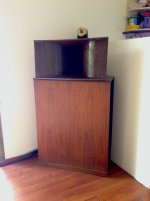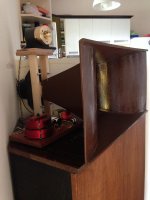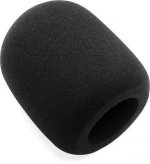I am in the process of getting another midrange horn.
Since now I have tried and own the stock Klipschorn squawker. Volti audio's 253hz Rectangular tractrix. 190hz rectangular tractrix I have built.
My compression driver BMS 4592nd-mid 16ohm.
My crossover point is around 360hz.
Who have tried JMLC 200t, Round Tractrix 200 and Iwata 200? I am eager to hear about experiences. I have read a lot about cf 300 horns, which people cross around 400 to 500hz. This sounds very different than crossing around 360 with bigger horns.
Since now I have tried and own the stock Klipschorn squawker. Volti audio's 253hz Rectangular tractrix. 190hz rectangular tractrix I have built.
My compression driver BMS 4592nd-mid 16ohm.
My crossover point is around 360hz.
Who have tried JMLC 200t, Round Tractrix 200 and Iwata 200? I am eager to hear about experiences. I have read a lot about cf 300 horns, which people cross around 400 to 500hz. This sounds very different than crossing around 360 with bigger horns.
Last edited:
I have used JMLC 200t with altec/gpa 288. Measures very smooth, and crossed at 350-400hz sound fine in my ears. But it is gigantic!
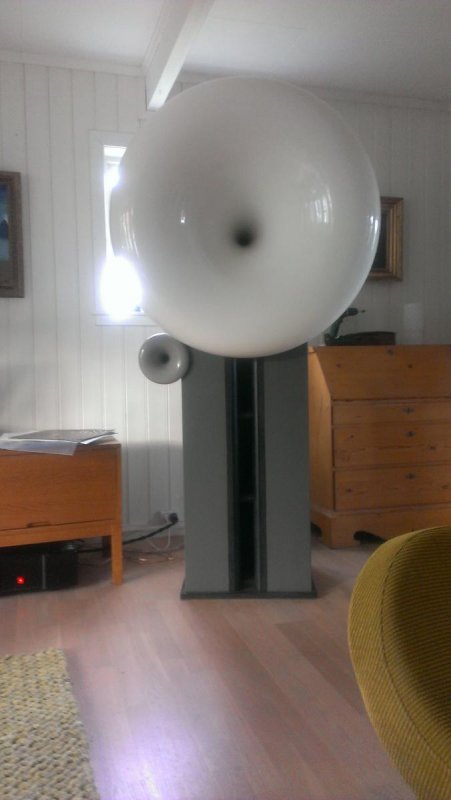
My biggest challenge was centre to centre distance when trying to integrate a tweeter. Eventually i gave up, and chose a horn with flatter profile (seos)

My biggest challenge was centre to centre distance when trying to integrate a tweeter. Eventually i gave up, and chose a horn with flatter profile (seos)
This is what i did now. I want to hear the JMLC 200t a lot, but positioning over the klipschorn bass bins and keeping the tweeter within reasonable height is a big problem.
If I use the 200 round tractrix I wont have that problem. However, I dont know if it would be better then the rectangular tractrix I have built.
Iwata seems to be something in between but no one I know has heard a 200 Iwata.
If I use the 200 round tractrix I wont have that problem. However, I dont know if it would be better then the rectangular tractrix I have built.
Iwata seems to be something in between but no one I know has heard a 200 Iwata.
Attachments
I have used JMLC 200t with altec/gpa 288. Measures very smooth, and crossed at 350-400hz sound fine in my ears. But it is gigantic! My biggest challenge was centre to centre distance when trying to integrate a tweeter.
I always believed that purchasing the 38" diameter * 25" deep JMLC 200t horn includes placing a bet that coaxial compression drivers like the BMS 4592nd or JBL D2430K can sound better than a separate 2" compression driver midrange horn + separate 0.63" compression driver tweeter horn.
How would you bet on the forward progress of coaxial compression driver technology ??
It would not bet on it on a horn like jmlc. I dont think a horn this big would ever be able to controll directivity all the way up. Btw, d2430k is not a coaxial. It uses two diagraphms to reduce distortion
I think the most successful way of using a large format driver without a tweeter is a Seos or jbl waveguide-like horn where directivity control is maintained all the way up to 10-15k
I think the most successful way of using a large format driver without a tweeter is a Seos or jbl waveguide-like horn where directivity control is maintained all the way up to 10-15k
I want to cover 360hz to 6500hz. Then I cross to my Fostex t500amkII's.
It seems JMLC 200t is too big and it would be very hard to integrate to my system physically.
I am now wondering about how the Iwata 200 and round tractrix 200 sounds against my 190hz rectangular tractrix...
It seems JMLC 200t is too big and it would be very hard to integrate to my system physically.
I am now wondering about how the Iwata 200 and round tractrix 200 sounds against my 190hz rectangular tractrix...
Yes.d2430k is not a coaxial.
And I haven't seen anything about using D2 below 800.
This is what i did now. I want to hear the JMLC 200t a lot, but positioning over the klipschorn bass bins and keeping the tweeter within reasonable height is a big problem.
If I use the 200 round tractrix I wont have that problem. However, I dont know if it would be better then the rectangular tractrix I have built.
Iwata seems to be something in between but no one I know has heard a 200 Iwata.
The Iwata isn't substantially different than what you already have..
Remember that a JMLC is all about the round-over - something you can achieve with ABSORPTION (and actually do a better job) with a round horn (not necessarily a tractrix) if you have interest in it.
The differences in dispersion between a round horn and what you have now will be noticeable, but no one can tell you if you'll like it better or not.
How do I achieve it with absorption. Where do I apply the absorption? The horns, the room?
Do you mean like what Peavey did?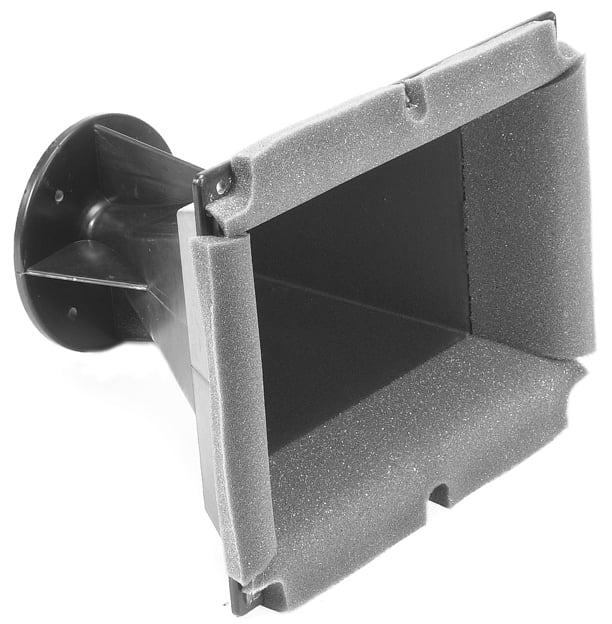
All around the edge of the horn's "mouth". Not dissimilar to what Peavy did (..and stole from Earl).
..think of it like a microphone shroud around the horn - perhaps a 4" wrap of rockwool around the horn - with a bit of overlap (1/2 inch) into the horn's "mouth" and an open cell foam "sock"/"shroud" covering that exactly like a mic shroud (perhaps "20 ppi").
Attachments
Last edited:
What are the things to consider when designing this? Stuff like, how much it should go into the mouth. Why did you say 1/2" and for what size mouth you have calculated it? How do I choose the thickness and the density of the foam? That would have an effect on certain frequencies more than others. Seeing as to how thick it could get (not much) it wont have much of an effect on most of the freq. close to the cf if I would use for cf200 horn... Or is it some other thing that I am missing out?
What are the things to consider when designing this? Stuff like, how much it should go into the mouth. Why did you say 1/2" and for what size mouth you have calculated it? How do I choose the thickness and the density of the foam? That would have an effect on certain frequencies more than others. Seeing as to how thick it could get (not much) it wont have much of an effect on most of the freq. close to the cf if I would use for cf200 horn... Or is it some other thing that I am missing out?
You'll have to do the empirical work on this.
The 1/2" was just a guess, and it depends on how you flare-out the exit.
The "foam" shroud should be low density - reasonably "transparent" acoustically.
The insulation wrap should be rated for good absorption for freq.s just below your horn's "cut-off" freq.. Here in the states I'd probably wrap it with "Ultratouch" - a denim insulation that can be a bit "unwieldy" because once you unroll it - it starts to fall apart.
http://www.bobgolds.com/AbsorptionCoefficients.htm
Last edited:
"(..and stole from Earl)."
BS, the foam on a Peavey horn is done for a different reason.
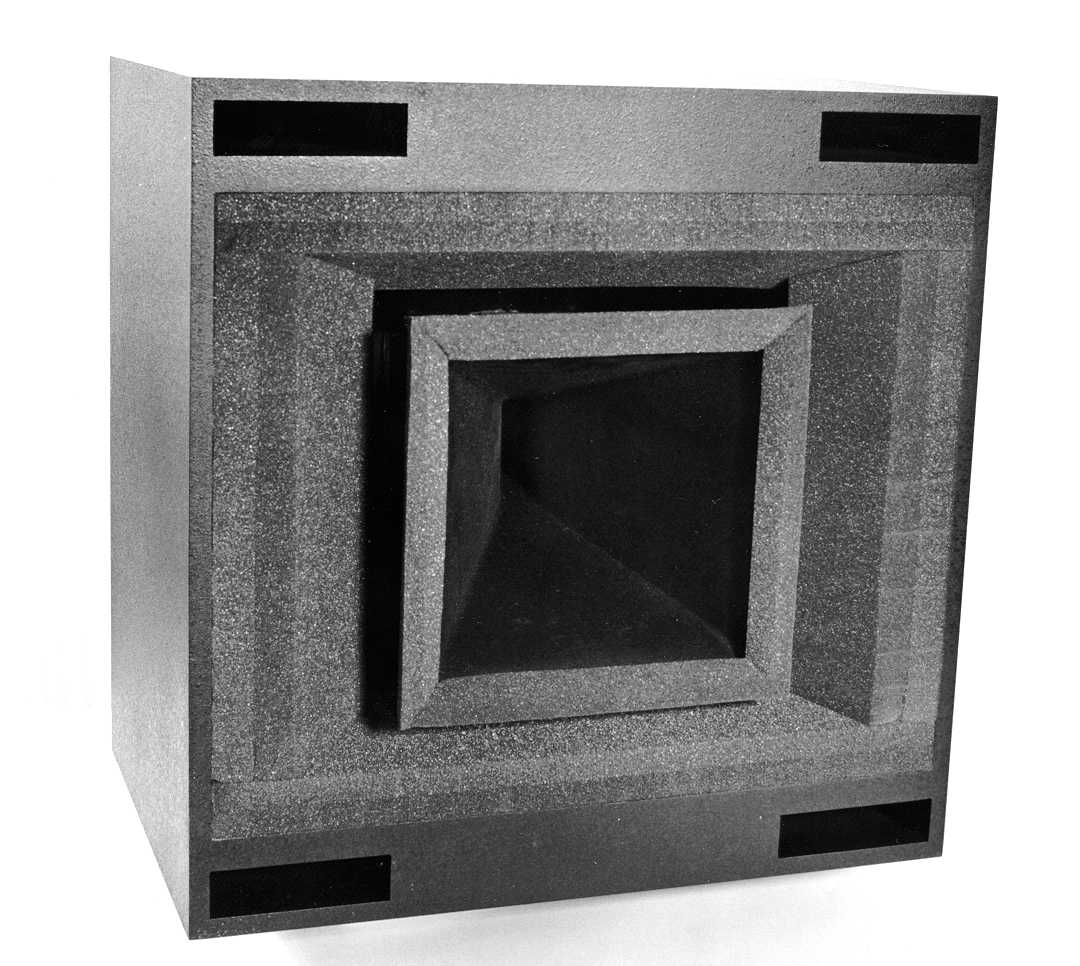
These Frazier Cat66 have been around for decades, you going to claim 'Earl' on these too?
Now John Meyer actually put the foam inside the horn throat, you going to claim 'Earl' on these too?

BS, the foam on a Peavey horn is done for a different reason.

These Frazier Cat66 have been around for decades, you going to claim 'Earl' on these too?
Now John Meyer actually put the foam inside the horn throat, you going to claim 'Earl' on these too?
It would not bet on it on a horn like jmlc. I dont think a horn this big would ever be able to controll directivity all the way up. Btw, d2430k is not a coaxial. It uses two diagraphms to reduce distortion
I think the most successful way of using a large format driver without a tweeter is a Seos or jbl waveguide-like horn where directivity control is maintained all the way up to 10-15k
this is correct. i use BMS 4592nd (coax) on 270 tractrix (BD design orphean horn) and it surely has an audible artifacts of running the whole range from 300hz all the way up.
on the other hand, i've heard a kind of an upgraded SEOS mid and HF horns with corresponding BMS mid and hi drivers, sounded absolutely superb and with none of beaming and slight honk. it was david haigner gama speaker (see bellow).
for sure two horns would be my choice if i would start again.
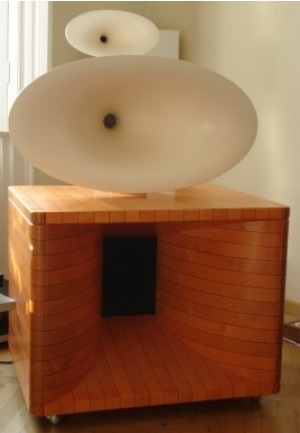
a foam in throat doesn't sound good. i had it in a DIY version of geddes summa, it kills transparency and detail. for me it was easier to live without it and cope with HOM consequences in the sound.
I have decided on a JMLC 270 as I also plan on expanding with other horns. I don't want to go into details as there is another thread on it (http://www.diyaudio.com/forums/multi-way/266064-full-range-5-way-horn-project.html)
The foam right in front of the driver doesn't seem to be a proper thing to do. Tonight I will try and hear how it effects the sound.
The foam surrounding the lip section of the horn like peavey does seem more reasonable. You can add kind of a flare with the foam. It may have a positive effect. I will try that too with the tractrix I have built.
The foam right in front of the driver doesn't seem to be a proper thing to do. Tonight I will try and hear how it effects the sound.
The foam surrounding the lip section of the horn like peavey does seem more reasonable. You can add kind of a flare with the foam. It may have a positive effect. I will try that too with the tractrix I have built.
kodomo,
Since you are putting a lot of effort into your horns and can construct your own, here is a possible solution ( experiment ) you can try.
Take a look at the Living Voice Vox Olympian speaker. They use a long, brass trumpet like horn. Perhaps it would be possible to drill a hole small through the large JMLC horn say 8" to 10" above the throat and poke that tweeter horn through. I have no idea how it might the sound but It may cause less grief then to have such a large center to center distance between the mid and the tweeter. Just an idea.
Since you are putting a lot of effort into your horns and can construct your own, here is a possible solution ( experiment ) you can try.
Take a look at the Living Voice Vox Olympian speaker. They use a long, brass trumpet like horn. Perhaps it would be possible to drill a hole small through the large JMLC horn say 8" to 10" above the throat and poke that tweeter horn through. I have no idea how it might the sound but It may cause less grief then to have such a large center to center distance between the mid and the tweeter. Just an idea.
"(..and stole from Earl)."
I think he's got a story about it around here somewhere.. something about a patent and a student I think. (..this is not talking about the throat filler that he also uses.)
Yeah, prior art suggests otherwise with respect to a "sustainable" patent.. People have been "wrapping" horns mouths/exits for as long as horns have been around - as far back as early Western Electric. ..not foam, but the effect is the same.
The foam right in front of the driver doesn't seem to be a proper thing to do. Tonight I will try and hear how it effects the sound.
I was only suggesting a thin very porous material, more like a very acoustically transparent "grill cloth" - to physically "bundle" the absorption material around the horn and give some measure of aesthetic "cohesiveness". (..this is not the same as Earl's use of the foam stuffing in the throat.)
The foam in the horn also affects frequency response (that's how it's supposed to work -- it attenuates HOM energy faster than non-HOM. But it attenuates HF energy either way). If you don't want to "kill the liveness" (i.e., change the frequency response) you have to pick the response back up again with EQ after adding foam.
- Status
- This old topic is closed. If you want to reopen this topic, contact a moderator using the "Report Post" button.
- Home
- Loudspeakers
- Multi-Way
- JMLC 200T vs Iwata 200 vs Roundtractrix 200 or other for 360hz crossover
